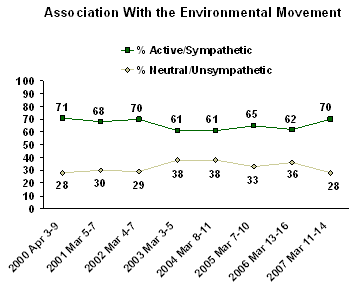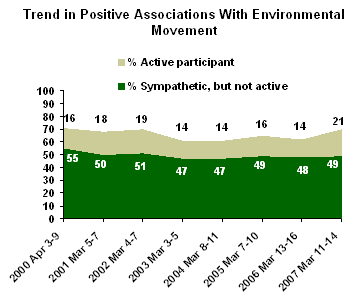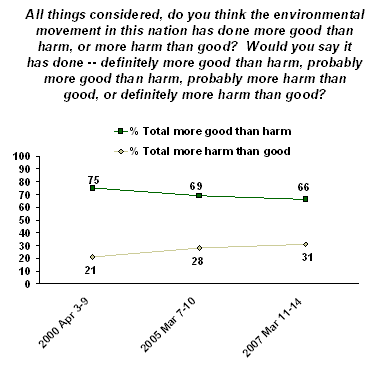GALLUP NEWS SERVICE
PRINCETON, NJ -- The environmental movement in the United States appears to have experienced hard times in recent years. It failed to get the United States to ratify the Kyoto Protocol aimed at reducing global warming, and has had little success in mounting an effective backlash against what it regards as the anti-environmental policies of the current Bush Administration. Indeed, in the post-9/11 era, it seems to some observers that environmental issues have been pushed to the periphery of the public agenda.
One indicator of concern for the health of the environmental movement within the movement itself is a 2004 report entitled "The Death of Environmentalism" (available online from The Breakthrough Institute), which received enormous visibility and generated a tremendous amount of debate (see, e.g, the symposium published in American Prospect, October, 2005).
On the other hand, according to a recent analysis of Gallup's 2007 Environment Poll, overall public concern for environmental quality has gradually increased since the onset of the post-9/11 era. (See "Environmental Concern Holds Firm During Past Year" in Related Items.) Furthermore, the recent attention given to global warming, stimulated by Al Gore's participation in the film "An Inconvenient Truth" and recent reports from the United Nation's Intergovernmental Panel on Climate Change, may be raising the salience of environmental issues more generally. (See "Did Hollywood's Glare Heat Up Public Concern About Global Warming?" in Related Items.)
Perhaps more importantly, in the absence of U.S. leadership in combating global warming, environmentalists have successfully lobbied several state and local governments to take action. And strikingly, a sector of evangelical Christians has recently become active in combating global warming, and promoting Christian stewardship of the environment more generally, creating the potential for a significant broadening of environmentalism's constituency.
Given these competing and conflicting indicators of the state of contemporary environmentalism, what does this year's Gallup Environment Poll, conducted Mar. 11-14, 2007, reveal about the public's view of the environmental movement and reported behavior on behalf of environmental protection? In particular, how do this year's results compare to those from Gallup's 2000 Environment Poll, conducted shortly before the 30th anniversary of "Earth Day" when environmental concern was relatively high?
Views of the Environmental Movement
In each of Gallup's annual Environment polls since 2000, respondents have been asked to report their relationship with the environmental movement as either an "active participant," "sympathetic, but not active," "neutral," or "unsympathetic."
In 2000, 71% of Americans reported being either an active participant in the movement or sympathetic toward it. Roughly 7 in 10 Americans continued to express this level of affinity for the movement each year until 2003, when the figure declined to 61%. It remained in the mid to low 60s until this year when it returned to 70%.

Although roughly the same percentage of Americans as in 2000 report being active in or sympathetic toward the environmental movement, the percentage indicating active participation has increased to 21%, slightly higher than has been recorded in previous years this decade, and 5 points higher than in 2000. Compared to 2000, this increase in the overall percentage of those who are "active" in the environmental movement appears to come from the ranks of the "sympathetics," as the percentages reporting being "neutral" or "unsympathetic" are about the same as the 2000 baseline.

(This noticeable rise in reported activism is reinforced by results concerning changes in Americans' specific environmental behaviors, discussed below.)
In contrast to these data that show Americans about as active in or sympathetic toward the environmental movement as in 2000, a different measure asking for Americans' assessment of the environmental movement's impact is more negative now than in 2000, though still strongly positive. Gallup asked respondents whether the environmental movement has done "more good than harm" or "more harm than good." This year 66% of Americans say the environmental movement has "definitely" or "probably" done more good than harm, 9 percentage points lower than in 2000.
These results suggest that the goals of the movement have become, as many have argued, increasingly contentious in recent years as reflected in political debates about global warming.

Environmental Behaviors
This year's poll also asked respondents to indicate whether, during the past year, they had engaged in each of a number of behaviors aimed at protecting environmental quality.
Two household behaviors, recycling and reducing energy use, are the two most popular actions, with the former reported by 89% and the latter by 85% of Americans. Their popularity likely reflects the growing ease of recycling (more curbside recycling programs and easier access to recycling centers in many communities) and a desire to save on utility bills.
The third most popular -- buying a product because it is seen as being better for the environment (70% ) -- would seem to reflect the continuing appeal of "green" consumerism. A much more activist orientation toward such consumerism -- complaining to a business about its environmentally harmful products -- is far less popular, and in fact comes in last on the list (only 9% of Americans say they have done this in the past year).
In between the two green consumerism items fall four behaviors that tap traditional environmental activism: support for environmental organizations and political actions. A large minority of Americans (43%) report contributing money to an environmental, conservation, or wildlife preservation group, while 19% report being active in a group or organization that works to protect the environment -- the latter lending credibility to the above-noted finding that 21% report being active participants in the environmental movement.
|
Which of these, if any, have you, yourself, done in the past year? |
|||
|
April 2000 |
March 2007 |
Pct. Pt.
|
|
|
% |
% |
|
|
|
Voluntarily recycled newspapers, glass, aluminum, motor oil, or other items |
90 |
89 |
-1 |
|
Reduced your household's use of energy |
83 |
85 |
+2 |
|
Bought product specifically because you thought it was better for the environment |
73 |
70 |
-3 |
|
Contributed money to an environmental, conservation, or wildlife preservation group |
40 |
43 |
+3 |
|
Voted for/worked for candidates because of their position on environmental issues |
28 |
35 |
+7 |
|
Been active in a group or organization that works to protect the environment |
15 |
19 |
+4 |
|
Contacted a public official about an environmental issue |
18 |
17 |
-1 |
|
Contacted business to complain about its products because they harm the environment |
13 |
9 |
-4 |
Of the two explicitly political behaviors, voting and/or working for candidates because of their environmental records is the most popular, with 35% of Americans reporting having done so in the past year. About half as many Americans (17%) report contacting a public official about an environmental issue.
In combination, responses to the items most directly tapping environmental activism reveal that a substantial minority of Americans engage in such activism. But has there been an increase since 2000? The percentage reporting voting/working for political candidates since 2000 increased 7 points (from 28% to 35%), while the percentage reporting being active in a group or organization rose 4 points (15% to 19%). Those contributing money to environmental groups may also have increased, although the 3 point increase (from 40% to 43%) is within the margin of error for comparing the two surveys. The percentage contacting a public official remained virtually unchanged (18% versus 17%). While modest, the three behaviors showing increases from 2000 to 2007 lend credence to the reported increase in active participation in the environmental movement (from 16% to 21%) noted above.
In contrast, the two household behaviors (recycling and energy reduction) remained virtually unchanged, while the two green consumerism behaviors (buying environmentally friendly products and complaining to businesses about harmful products) showed slight declines, from 73% to 70% for the former and 13% to 9% for the latter.
While some of the changes noted above are within the range of sampling error, the overall pattern suggests a slight increase in traditional forms of environmental activism since 2000, while hinting at the possibility of a decline in green consumerism. More broadly, there is no indication of a substantial increase in environmentally related behavior since 2000, a finding that may be surprising to many who assume that there has been a major increase in environmental activism in recent years.
Conclusion
The annual Gallup Environment Poll focuses only on the general public, and thus cannot judge the overall state of the environmental movement. However, taken in conjunction with reports of growing membership in many environmental organizations and increased participation in local/state campaigns to combat global warming, this year's results suggest that pronouncements of the "death of environmentalism" have been premature.
Although Americans are somewhat less likely to see the environmental movement as doing more good than harm than in 2000, they are a bit more likely to report being active on behalf of the movement than was true at the 30th anniversary of Earth Day.
At the same time, it is apparent that despite their intense displeasure with the policies of the current Bush Administration, environmentalists have not been able to generate a widespread backlash and significantly increased public activism akin to what they stimulated in the early years of the Reagan administration -- which they also saw as trying to weaken environmental protection policies. (See "No Environmental Backlash Against the Bush Administration" in Related Items.) It is clearly proving harder to rejuvenate environmentalism in post-9/11 America than it was in the early 1980s.
In sum, this year's Environment Poll suggests that the environmental movement is experiencing a slight rebound since 9/11 and the Iraq war presumably distracted Americans from domestic issues such as environmental quality. Whether the movement will continue to garner support, and once again become a potent force influencing national policy-making, remains to be seen.
Riley E. Dunlap, Gallup Scholar for the Environment, is currently Professor of Sociology at Oklahoma State University. He contributed an essay to a "Death of Environmentalism" symposium published in the March 2006 issue of Organization & Environment.
Survey Methods
Results are based on telephone interviews with 1,009 national adults, aged 18 and older, conducted Mar. 11-14, 2007. For results based on the total sample of national adults, one can say with 95% confidence that the maximum margin of sampling error is ±3 percentage points. In addition to sampling error, question wording and practical difficulties in conducting surveys can introduce error or bias into the findings of public opinion polls.
